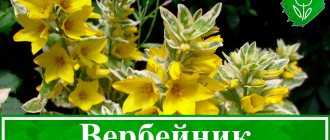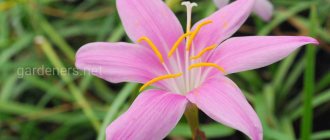Among many ornamental plants, Laurentia stands out not only for its abundant, but also very long flowering. And in this, with its discreet but graceful beauty, it can easily compete with the most popular flowering species.
The botanical name of Laurentia is Isotoma. This is a perennial herbaceous plant belonging to the Lobelaceae subfamily of the large Campanaceae family. It comes from Australia, appeared on the European flower market not so long ago and is still considered a novelty.
Laurentia flowers are apical, solitary, shaped like small stars. The corolla, fused at the bottom into a narrow tube, at the top when open, consists of 5 narrow petals of a delicate blue, lilac, lavender, pink or white color. The diameter of the flowers is from 7 mm to 3.5 cm, but even on a single plant there are so many of them that it resembles a real scattering of stars. Flowering usually begins in early summer and continues until September–October.
Laurentia leaves are also decorative, bright green, shiny, elongated in shape, pinnate, slightly cut. They even seem prickly at the edges, but in fact, they are soft and fragile. Most types of isotoma grow in the form of small rounded bushes 10–30 cm high, but there are varieties with creeping shoots that can be grown as ground covers. No additional haircut or pruning of shoots is required. However, it is important to know that precautions are needed when working with them; the plant contains poisonous juice that can cause burns.
Laurentia is good in monoculture and in combination with other ornamental plants. In mixed plantings, for example, it will disguise the lower part of tall perennials, and large and bright flowers against its background will look even more advantageous. It is attractive not only in a flowerbed, but also on an alpine hill, both in small and large flower pots, as well as in hanging flowerpots, from which openwork shoots hang down, like hanging plants.
Botanical description
Laurentia is a herbaceous perennial plant that belongs to the Campanula family. In open ground it is grown as an annual. Many gardeners often use its second name, “isotome.” This flower is native to Australia. Due to its spectacular decorative properties, it is grown in pots, along borders, and in flower beds.
The plant forms small bushes with lateral shoots. Its height reaches 10-30 cm. The root system is strong, deeply penetrating, capable of absorbing moisture from the lower layers of the soil. Along the entire length of the stem there are bright green pinnate leaves with pointed edges. The flowers are shaped a bit like five-pointed stars. Their diameter ranges from 0.9 to 3.5 cm. Isotoma is represented in purple, lilac, pale blue, and white.
Laurentia is quite sun-loving and moisture-loving. Flowering is abundant, taking into account the large increase in green mass. It starts in May and ends in mid-September. In the process, small boxes are formed that contain the seed material.
Important! Isotoma juice has poisonous properties. If it comes into contact with the skin, it can cause burns. To avoid such troubles, care is carried out with gloves. Animal access is also restricted.
Varieties and types
Growing pyrethrum: instructions, from seeds, from seedlings, planting and care
Laurentia River is a herbaceous perennial plant with creeping stems that form a continuous green carpet. The branches of the crop are long, with lush foliage. The leaf blades are small, with patterned edges of a dark green hue. The inflorescences are small, pale purple. The plant blooms from early summer to early autumn.
Isotoma Tristar - is a lush, spherical shrub with a diameter of up to 25 centimeters. The shoots are long, creeping type. The leaf blades are located along the entire length of the branch; they are small in size and dark green in color. The inflorescences have five petals in white, pink or blue. The plant blooms from early summer until the first frost.
Laurentia Axillaria is a low perennial, slowly growing plant characterized by vigorous flowering. Laurentia branches spread along the ground and form a green carpet. The leaves of this crop variety are small, patterned, and dark green in color. The inflorescences are located at the end of the branches and have a lilac hue. Flowering time occurs at the beginning of summer and ends in September.
Laurentia hybrida - A shrub with erect branched shoots reaching a height of up to 45 centimeters. The branches have lush foliage. The leaf blades are small with jagged edges and have a dark green tint. The inflorescences are five-petalled and have pink, white and lilac tints. The plant blooms from early May to late September.
Laurentia Vanguard Blue
The plant reaches a height of up to 30 centimeters and looks like a lush spherical bush. The branches of isotoma are decorated with multiple rich green leaves with carved patterns along the edges. The inflorescences have five petals and a light lilac hue. This variety of Laurentia blooms throughout the summer.
Laurentia Fantasy Blue is a spherical bush with a diameter of 30 centimeters. The branches are long with luxurious foliage. The leaf blades are small, dark green with a patterned edge. The inflorescences are small, reminiscent of a blue night violet. Flowering time occurs at the beginning of summer and ends in September.
Laurentia BlueStars - the plant reaches a height of up to 30 centimeters and has the shape of a ball. The branches are long with dense foliage. The leaves are a rich green hue, small with patterned edges. Inflorescences are pale blue, multiple with five petals. Laurentia blooms from early June to late September.
Laurentia StarlightPink - the shrub has a spherical shape and dense long shoots. The leaf blades of the plant are pinnately dissected, small, and dark green in color. The inflorescences are a delicate salmon color with five elliptical petals. This variety blooms throughout the summer.
Varieties of Isotoms
Isotoma appeared on the domestic market relatively recently.
The most common types are:
- River.
- Axillary.
- Hybrid.
River - characterized by creeping stems forming a dense carpet, lilac small flowers. It can withstand light frosts, and in mild climates it can overwinter without shelter. This variety is suitable for moist soil and partial shade. Wetlands are not recommended. When planted in pots, the shoots hang down, forming an ampel shape. The most popular variety is Country Park (small blue and lilac flowers).
Axillary is a low plant with abundant flowering and small foliage growth. The height of the bushes reaches 10-30 cm. The flowers are predominantly lilac in color, reaching almost 3 cm in diameter. The seeds of axillary laurentia appeared on the domestic market relatively recently. It is not resistant to cold, so it is grown only as an annual. The most popular are two hybrid varieties: Blue Stars (blue flowers) and Starlight Pink (pink flowers).
Hybrid is a type of isotome obtained by crossing previous ones. The main feature is the rapid transition to the flowering phase, rapid growth (faster than maternal ones). The stems form dense bushes, reaching a height of about 40 cm. During the flowering process, they are completely covered with flowers, reaching 1.5-3 cm in diameter.
Hybrid is characterized by stress resistance to weather conditions. In damp and cool weather, the number of buds does not decrease. While other plants experience stress or even die. At Russian latitudes it is grown as an annual, although it is a perennial. Hybrid Laurentia is represented by the varieties White Star (white inflorescences) and Vanguard Blue (large pale blue flowers). Laurentia Avangard Blue is suitable for growing in pots because it is a very heat-loving variety (see photo).
Laurentia Vanguard Blue
Types and varieties of pyrethrum with photos and names
About 100 species live in the natural environment, and almost half of them are cultivated. Let's look at the most popular ones.
Pyrethrum parthenium
Pyrethrum parthenium photo
Tanacetum maidens is grown as an annual or perennial. The height of the branched bush is 50-55 cm. The leaves are colored light green with a yellowish tint. Inflorescences can be simple or double. Painted white or pale yellow. The diameter of the inflorescence is up to 4 cm.
Varieties:
- Goldball – stem height reaches 30 cm. The inflorescences are bright yellow;
- Double White – small, double flowers – like white clouds;
- Schneeball is a miniature bush about 20 cm high, the flowers are small, white in color with a yellow center.
Pink pyrethrum or Persian chamomile Pyrethrum roseum
The plant is 50-70 cm high. About 5 inflorescences with a diameter of up to 6 cm appear on each peduncle. The color is pink. In varietal plants, the diameter of the inflorescence reaches 12 cm.
Known varieties:
- Robinson - color from dull to bright pink;
- James Kelver - the inflorescences are red;
- Brenda - dense inflorescences have a scarlet tint;
- Vanessa - double inflorescences, have all shades of pink.
Red feverfew or Caucasian chamomile, bright red tansy Pyrethrum coccineum
Red feverfew or Caucasian chamomile, bright red tansy Pyrethrum coccineum photo
The plant is about 60 cm high. The core is yellow, the petals are various shades of red.
Pyrethrum corymbosum
Pyrethrum corymbosum photo
It has a stem 1.2 m high. Very similar to field chamomile. Flowers are collected in loose clusters.
Pyrethrum macrophyllum photo
Numerous small flowers are collected in an inflorescence, forming a ball. The flowers are white at first but become yellow-brown over time.
Features of care
Isotoma is considered not too whimsical and quite easy to care for. Despite this, certain conditions must be observed in order to grow a beautiful plant. The main points are soil characteristics and place in the garden.
Laurentia prefers loamy soils or sandy loam substrates with neutral acidity. Good drainage will be required from time to time.
The plant prefers sunny places and produces good growth and flowering in diffused light and partial shade. No wind protection required. But weeds need to be pulled out regularly.
Watering is provided regularly, but the ground is not flooded. If there is a lack of soil moisture, the foliage begins to turn yellow. When water stagnates, the rhizomes rot.
When growing Laurentia in the house, it is worth controlling the temperature at 15-22 degrees and periodically humidifying the air. With good care and additional lighting, abundant flowering can be achieved in an apartment.
Moderate feeding is required and is carried out regularly during the period of active growth. Organic fertilizers are used, namely: humus, wood ash, manure. When feeding with chemicals, the plant begins to stretch, and the number of buds decreases. For these reasons, you shouldn’t get carried away with them. Does not require pruning to give shape. Pinching is also not done - this does not affect the rate of appearance of side shoots.
Growing Laurentia Avangard Blue from seeds, photo:
Types and varieties of pyrethrum
Not many types of pyrethrum are grown in culture, but this plant has many garden forms and varieties.
Beautiful pyrethrum (Pyrethrum pulchrum = Tanacetum pulchrum)
in the wild it is found in Central Asia, Northern China, Northern Mongolia, Kazakhstan and Siberia. It grows in the tundra, on rocky slopes and placers near glaciers. Pyrethrum beautiful is a semi-rosette rhizomatous perennial up to 50 cm high, pubescent with twisting hairs. Its few erect stems are weakly leafy. Green, long-petiolate, glabrous or sparsely pubescent, double pinnately dissected basal leaves reach a length of 15 and a width of 2 cm. The stem leaves are sessile. Collected in inflorescences of 2-3 pieces or single baskets, they consist of white reed and gray tubular flowers.
Reproduction
Reproduction occurs through seeds, cuttings, and root division. The last two methods are used when it is necessary to grow several bushes. The most optimal way to sow a large area is to grow Laurentia from seeds. With its help, group planting is ensured, which emphasizes all the beauty of the plant. It is suitable for landscaping areas without bushes and trees. Laurentia completely covers the ground with a dense carpet, leaving no bare areas or bald patches.
Axillary and River grow slowly; it is preferable to grow as seedlings. In order for flowering to begin as early as possible, it is recommended to sow in December-January. Place drainage at the bottom of the container, followed by pre-moistened soil. It is preferable to use a moisture-intensive and light substrate; high-moor peat is suitable for these purposes.
The seeds are deepened by 7-10 cm. Then the pots are covered with glass to create a greenhouse effect. The seedlings are ventilated every day. The sprouts sprout within 14 days. Picking is carried out 30 days after germination. Transplantation into the garden is carried out in May-June.
Sowing in open ground can be done immediately with Hybridnaya, due to its rapid germination after planting and rapid growth. The first buds appear after approximately 1-1.5 months, unlike other varieties.
Before sowing, the soil is fertilized and carefully leveled. To speed up the growth of seedlings, you can create a greenhouse effect. The optimal period for the event is mid-to-late May.
Reproduction using cuttings is possible when the plant reaches two years of age. This method is suitable for growing Laurentia at home. The cuttings are placed in a container of water or soaked in stimulants for a couple of hours. Rooting occurs in sand, perlite or special peat tablets.
You can also reproduce by division. Its advantage is faster growth and flowering. For this vegetative propagation, you will need to dig up the bush and cut it so that the above-ground part and root remain.
The event is held in October. The bushes are planted in separate containers in a warm room with good lighting. Transplantation is carried out after the last frost, somewhere in mid-May.
Previously, it was possible to propagate isotoma only by cuttings due to a shortage of seeds on sale. Now the seed method is considered the most effective.
Laurentia in landscape design
Isotoma is used as a monoculture and also makes a good combination with other ornamental plants. Many varieties have pastel colored inflorescences. To create winning compositions, it is recommended to combine them with bright and large flowers. These can be marigolds, petunias, peonies, delphinium. Tall, large perennials go well together - Laurentia will decorate and disguise their lower part.
Massive plantings of several bushes that create a dense carpet look good. Flowers are grown in small and large pots, on alpine hills, and flower beds. An excellent design solution is to grow Laurentia in hanging pots. They are hung in gazebos, along verandas and railings.
Photo of blooming Laurentia:
Diseases and pests
The advantages of Laurentia are its resistance to almost all pests and diseases.
For example, slugs and snails never harm plant shoots at all. But spider mites and aphids sometimes attack plantings. This happens due to the fact that Laurentia is in unfavorable conditions. And unfavorable conditions for it are too high a room temperature. If you properly care for Laurentia, it will decorate the garden with delicate and romantic star flowers. Its unpretentiousness and ease of propagation make the plant one of the most popular in landscape design.
"Lunnik perennial"











